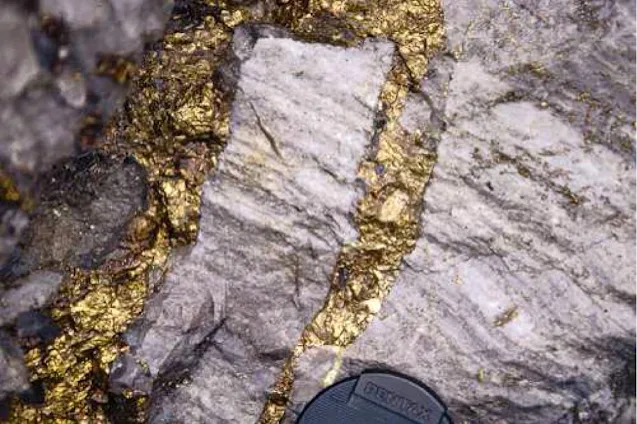Veins and Hydrothermal Deposits
Veins are mineral deposits which form when a preexisting fracture or fissure within a host rock is filled with new mineral material. The deposition of minerals is typically performed by circulating aqueous solutions. Many ore deposits of economic importance occur in veins.
Vein deposits are believed to form when aqueous solutions carrying various elements migrate through fissures in rock and deposit their burden onto the fissure walls. Hot, rising water escaping from cooling igneous plutons may deposit minerals as it ascends through the crust.
As heated magmatic waters rise, the temperature and pressure of their environment drop and minerals exsolute and crystallize. Meteoric ground water may also percolate down through the earth's crust, dissolving surface minerals and gaining heat from the geothermal gradient or from nearby igneous intrusions. At greater depths the dissolved substances may precipitate and crystallize along the walls of the fissures and cavities through which the water travels.
 |
| Gold Vein |
Most vein deposits are formed as new mineral species are precipitated onto rock walls which themselves remain unaltered. In such cases mineral deposits fill the original crack or fissure in the host rock but do not extend into the host rock itself. The boundary betwen host rock wall and deposited vein minerals therefore remains clearly delineated.
Vein deposits of this nature are a type of hydrothermal deposit because the mineral species which compose the veins were precipitated by hot waters. However, sometimes the preexisting rock wall which contains the vein undergoes alteration. Portions of the host rock may either dissolve and be transported away or else react chemically with the circulating volatile fluids or the newly formed mineral species.
In this case the boundary between vein deposit and original rock wall will be unclear. If most of the mineralization process occurs within the space once occupied by unaltered wall rock then the vein is termed a hydrothermal replacement deposit.
A hydrothermal replacement deposit occurs when hot circulating aqueous solutions replace the original rock with new mineral species. This typically occurs in more soluble rocks such as limestone. Hydrothermal replacement deposits are a form of hydrothermal metamorphism or metasomatism.
Hydrothermal Deposits
Hydrothermal deposits are valuable mineral accumulations formed by the precipitation of dissolved metals from hot, mineral-laden water circulating through Earth's crust.
These hot, mineral-laden fluids can originate from several sources
Magma chambers: Hot water can be expelled from magma chambers as it cools and crystallizes. This water is rich in various dissolved metals and other minerals.
Rocks deep in the Earth's crust: Groundwater can be heated by the Earth's internal heat and rise through fractures in the crust, dissolving minerals along the way.
Mid-ocean ridges: Seawater can be heated by volcanic activity at mid-ocean ridges and circulate through the surrounding rocks, forming hydrothermal vents that release mineral-rich fluids.
Types of Hydrothermal Deposits
Hydrothermal deposits are categorized according to the depth and temperature at which they formed. Hypothermal deposits are formed at great depths and high temperatures; mesothermal deposits at intermediate depths and temperatures; and epithermal deposits at the shallowest depths and relatively low temperatures.
Some mineral species crystallize mainly at preferred temperatures and pressures. Because the temperatures and pressures are different for each type of hydrothermal deposit, each has a different, characteristic set of associated minerals.
Hypothermal deposits
Hypothermal deposits are formed at great depths and high pressures and temperatures. Temperatures may range from 300° to 500° Celsius during the formation of such deposits. Casseterite, wolframite and molybdenum veins; gold-quartz veins; copper-tourmaline veins; and lead-tourmaline veins provide examples of mineral associations which may occur in hypothermal deposits. Minerals which are found in hypothermal veins include quartz, fluorite, tourmaline, and topaz. Ore minerals found may include native gold (Au); the sulfides galena (PbS), chalcopyrite (CuFeS2), pyrite (FeS2), molybdenite (MoS2), bismuthinite (Bi2S3), and arsenopyrite (FeAsS); the oxides uraninite (UO2), cassiterite (SnO2), and magnetite (Fe3O4); and the tungstates wolframite ((Fe,Mn)WO4) and scheelite (CaWO4). Metals which may be extracted from hypothermal deposits consist of copper (Cu), molybdenum (Mo), tin (Sn), tungsten (W), gold (Au), and lead (Pb).
Mesothermal deposits
Mesothermal deposits form at intermediate depths, temperatures, and pressures. Temperatures may range from 200° to 300° Celsius during the formation of such deposits. Quartz and carbonate minerals such as calcite (CaCO3), ankerite (CaFe(CO3)2), siderite (FeCO3), dolomite (CaMg(CO3)2), and rhodocrosite (MnCO3) occur in mesothermal deposits. Ore minerals which may be found include native gold (Au) and the sulfides galena (PbS), sphalerite (ZnS), chalcopyrite (CuFeS2), pyrite (FeS2), bornite (Cu5FeS4), arsenopyrite (FeAsS), and tetrahedrite ((Cu,Ag)12Sb4S13). Metals which are mined consist of copper (Cu), zinc (Zn), silver (Ag), gold (Au), and lead (Pb).
Epithermal deposits
Epithermal deposits form at shallow depths under relatively low temperatures and pressures. Temperatures during formation may range from 50° to 200° Celsius. Minerals found include quartz, opal, and chalcedony (SiO2); calcite (CaCO3), aragonite (CaCO3), and dolomite (CaMg(CO3)2); the halides fluorite (CaF2) and chlorargyrite (AgCl); the sulfate barite (BaSO4); native gold (Au); and the sulfides realgar (AsS), cinnabar (HgS), acanthite (Ag2S), pyrite (FeS2), orpiment (As2S3), stibnite (Sb2S3), proustite (Ag3AsS3), and pyrargyrite (Ag3SbS3). Metals which are mined from epithermal deposits include silver (Ag), gold (Au), and mercury (Hg).

%20(1).webp)






